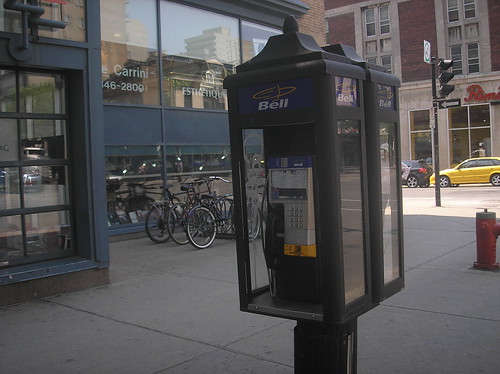
Next time your cell dies and you dig out a quarter for a payphone, you’ll have to dig a little deeper. After the go-ahead from the CRTC earlier this summer, Bell has doubled the price of local calls to fifty cents. The reason given is the cost of payphone upkeep. This move will likely lead to a further decrease in their usage as frustrated Montrealers simply cease to uncoil their silver-chained receivers. This, of course, justifies the continued phase-out of the public phone, admittedly not the heftiest revenue earner for Bell Canada, Canada’s largest phone service provider.

The disappearance of that little black box will make its absence known gradually, but decisively. In the past it has provided relief to countless Canadians exploring the vast countryside, and a quick (and sometimes anonymous) call for emergencies, either large or small, in our cities. And of course, the increasing number of Canadians hovering around and falling below the poverty line rely most heavily on their availability. As many people have pointed out, pay phones are a public service – like fire hydrants, parks, and public washrooms – they are an integral (and oft over-looked) component of the urban fabric. At the rate they are disappearing – about 4,000 pay phones every year nation-wide – how long before Montreal feels the phone crunch? And is there anything that can be done?
In 2004, the CRTC declared pay phones an essential service however they don’t require companies provide them. Instead, they added a clause to protect existing payphones: if the last pay phone in a community is to be removed, the company must notify everyone in a high-profile way, such as running a newspaper ad. In the wake of the recent rate hike, the national Public Interest Advocacy Centre asked the CRTC to force Bell to operate certain Public Interest Payphones (PIPs) in places with little or no profit-generating potential. But the CRTC didn’t budge, saying that it wouldn’t interfere by imposing a heavy administrative and financial burden on the multi-billion dollar industry.
The trend of removing payphones in favour of private cell phones has been underway across the U.S. and throughout Western Europe for several years now.
However, there’s a key difference in these two cases: in places like Finland, where citizens use their cell phones to cast a straw vote on the parliament’s business of the day, this technology is actually realizing its democratizing potential. In the U.S., pay phone deregulation has had the opposite effect. While a whopping 200 million people have cell phones, the number of pay phones has decreased from 2 million to 1.3 over the last ten years and many gaps have also formed in the provision of basic services like land lines. Most often the communities left in the lurch are low income, Native American or located in remote areas. Located somewhere between these poles, which route will Canadian telecom take?
Until cell phone technology becomes truly democratic, pay phones will remain an important feature in cities like ours. Fortunately not all companies are taking Bell Canada’s lead; for now, it still costs just one shiny quarter to use a Telus pay phone. Also, AT&T phones remain a somewhat more reasonable (if inconvenient) $0.35. Where are these last remaining, non-Bell payphones? Add your favourite phone locations to the comments section.
Sources:
CBC.ca, blogTO.net, NOW Magazine, NY Times
